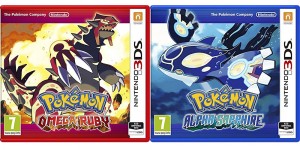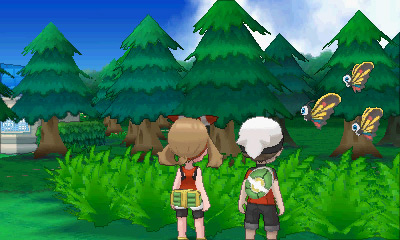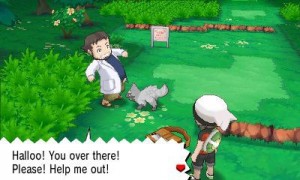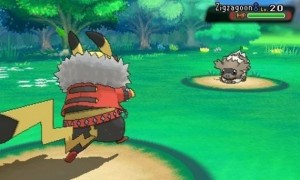
Developer: GAME FREAK
Publisher: Nintendo
Genre: RPG
Platform: Nintendo 3DS
Released: 28/11/2014
The third generation of Pokémon games, Ruby & Sapphire, were released on the Game Boy Advance over ten years ago. Now the game that introduced us to MIDI-trumpets and large swathes of water receives the remake treatment. After years of calls from fans to bring back Hoenn, we can say that the wait was certainly worth it, with a pair of games that take an approach of both looking back at the good times and bringing it all up to speed with the present.
GAME FREAK have endeavoured to remain faithful to the original games, so Omega Ruby & Alpha Sapphire will feel very familiar to those who played Ruby & Sapphire. The madcap Professor Birch is still being chased by rogue Pokémon in the tall grass, Team Magma and Team Aqua are still up to no good, and there’s still a large region to explore with over 200 monsters to capture.
The plot of these remakes is largely the same as the originals, albeit with a few tweaks here and there and an all-new epilogue which adapts the events of the 2004/5 movie Destiny Deoxys. You take the role of Pokémon trainer Brendan or May, having just moved to the Hoenn region. After being given a starter Pokémon by Professor Birch, you set off on your journey to become the Pokémon League champion, while saving the world from the plots of Team Magma expanding the land (in Omega Ruby) or Team Aqua expanding the sea (in Alpha Sapphire) by using the power of the super-ancient Pokémon Groudon and Kyogre.
While it will please some fans in remaining faithful to the original games, in many areas Omega Ruby & Alpha Sapphire feel a step backwards from X & Y. The difficulty of the game seems easier than ever, with not one opponent in the single player game posing a challenge; the dreams of having a true difficulty select stuck in the days of Black and White. Gone are the vast array of trainer customisation options, leaving you stuck with an uninspired redesign of the original Brendan and May models; the Pokémon Centre and PokéMart facilities have been split into two buildings again, the text boxes have the terrible green background and red border which made the originals so unreadable, and some of the sensible TM/HM teachable move revisions have been reversed. While these changes keep things consistent with Ruby & Sapphire, it often feels like a missed opportunity, particularly when a later story point attempts to write the different strands of the original games and the remakes into cannon. There’s plenty of positives in the design though – Team Magma and Team Aqua have more personality than they ever had in Ruby & Sapphire, with a distinct set of characters that you can easily become attached to, helped along by the better scriptwriting which has seen continuous improvements since the story-heavy Black & White. There’s some genuinely funny moments and each character is given a voice, rather than being just another person to battle.
X & Y’s 3D engine offers a lot to these remakes over Ruby & Sapphire, and looking back it’s not hard to appreciate how far the series has come in the last ten years; ditching the 2D sprites for what is an exceedingly pretty looking world with a lot of vibrant colours. The engine gives everything a lot of life, and has seen some improvement since X & Y, with a lot more visual effects and an improved frame rate during battles. The old 3DS still struggles at times, but take this to the New 3DS and it feels like this was the right direction for the franchise to move in.
In terms of features and mechanics, Omega Ruby & Alpha Sapphire attempt to cherry pick the best bits of the franchise, and while it brings back some features that were missed from the third generation, it fails to capitalise on the successes of newer features. While Ruby & Sapphire’s trademark double battles are still the core focus of the mechanics, there’s also triple and rotation battles from Black & White, and horde and inverse battles from X & Y. While double and horde battles are well placed, there is still a severe lack of triple and rotation battles, both of which seem to be resigned to a multiplayer experiment by GAME FREAK. That’s a shame, as both types of battles offer a different kind of strategic outlook than just matching the correct move to the correct Pokémon. Being fair, you don’t want to fix something if it’s not broken, but having some battle variety could pay off in shaking up the formula.
One of the biggest battle changes since Ruby & Sapphire was Mega Evolution, and this becomes even more prominent in Omega Ruby & Alpha Sapphire, introducing an extra twenty Mega Evolutions (22 if you count Groudon and Kyogre’s Primal Reversions, which are essentially the same thing) in addition to the 28 present in X & Y. Although you don’t get access to it until you have completed the story, Mega Evolution brings in one of Omega Ruby & Alpha Sapphire’s coolest features: soaring. Once you have the Eon Flute, Latias/Latios and their respective mega stone in your possession; you can use the flute to fly around a fully realised 3D overworld of Hoenn. This is what feels as the successor to using the Fly HM, and is more immersive than just hitting a button and switching location. The sky is dotted with flocks of flying Pokémon which can initiate battle with some of the rarer types, if you can collide with the flock at the right spot. It’s not the smoothest experience, but it certainly makes the skies feel alive. Soaring also introduces a new key feature of these games: Mirage Spots. Mirage Spots are islands dotted about in the sea surrounding Hoenn which you can pick up from other players through Spotpass. Crucially, special Mirage Spots are the only way to capture select legendary Pokémon from previous games. It’s a neat way of giving players a better chance at catching them all, but with the inclusion of past legendary Pokémon from previous generations increasing in each successive game, there is a sense of devaluation of legendary Pokémon being a one-time capture.
Catching Pokémon has had a bit of a shake up with the new sneaking mechanic. Movement on the circle pad is linked to how far you push it – taking it to the edge will result in a brisk walk, but hold it closer to the centre and you will tiptoe along. This is key to catching the rarer Pokémon who hide in the shaking grass, which sees its best implementation here since its introduction in Diamond & Pearl. If you creep along, you can easily get into a battle with these Pokémon, which have a raised chance of being one of the different-coloured ‘shiny’ Pokémon, having a hidden ability (extra effects which can be used in battle, for example Intimidate lowers an opponent’s attack at the start of battle), or having a move that it can’t usually learn through levelling up. You can find these shaking spots easier by using the DexNav, which conveniently shows the Pokémon you discover in an area. Once you’ve caught at least one of a Pokémon, tapping its DexNav sprite activates a series of shaking spots which can be chained to raise your success rate in getting one of these rarer types.
This is part of the PokéNav Plus, which continues the line of the in-game smart devices, providing useful functions such as a map of the Hoenn region, and a feed of events that have happened in either your game or a friend’s. It’s often a useful tool, but is often at odds with the apps that form the lower screen features of X & Y (Player Search System, Pokémon Amie, and Super Training). While in X & Y the three core apps were very accessible, Omega Ruby & Alpha Sapphire has them as a sub-app of the PokéNav Plus, which with the way its interface is structured, makes it inconvenient to switch between the game’s multiplayer and single player functions. It feels like the mashing together of two incompatible ideas, and it makes the UI clunky to use.
Outside of battle and catching Pokémon, there are a variety of minigames available of which some work better than others. From X & Y there is the return of Super Training and Pokémon Amie, both of which aren’t worth your time unless you are doing a specific action. Super Training is an easy way of raising your Pokémon’s base stats (sometimes called effort values or EVs) where you fire balls at balloons in order to pop them, earning your Pokémon EV points, increasing its base stats. As a minigame it works as a distraction, but when it takes about an hour to fully EV train a Pokémon using special items you can find and allow your Pokémon to hold and using the horde battles to gain lots of points, there is no real need to use Super Training. Pokémon Amie allows you to feed your Pokémon PokéPuffs to raise their level of happiness and provide certain other in-battle effects in single player. Just as with Super Training, there are already faster ways of building your Pokémon’s happiness and is at best a throwaway distraction.
Both contests and secret bases return from Ruby & Sapphire in their new forms of the Pokémon Contest Spectacular and Super Secret Bases. The best of these features is Super Secret Bases, which offers you the ability to create your own hideout out in the field using the move Secret Power. These bases can be decorated using a variety of items and furniture just as they could be in Ruby & Sapphire, but this time around they are able to fully utilise multiplayer thanks to the 3DS’ online and Streetpass functionality. The secret bases of players you meet either online or through Streetpass will be downloaded and placed in your game. While this allows you to view other players’ secret bases, the neat trick is that you can recruit players to join a team, adding them into your secret base for other players (or yourself) to battle.
Pokémon Contests offer an alternative way to play the game, which can be particularly fun after you’ve finished the main story. The goal of contests is to outperform your opponents by using moves of a certain theme to appeal to an audience. There are five themes; tough, cool, beautiful, cute and clever; and each move fits into one of these themes. You train a Pokémon by feeding it PokéBlocks to raise its stat in a specific category and by giving it moves of the correct type. Contests can be a good time-waster, particularly for younger players; but there is often too much riding on luck for this to be a concrete type of play.
Unlike other games in the series, Omega Ruby & Alpha Sapphire features an epilogue in the Delta Episode, which, as mentioned previously, loosely adapts the events of the Pokémon movie Destiny Deoxys. While only a few hours long, it offers a different perspective on the mythology surrounding the legendary Pokémon and ties the loose ends at the end of the main story together nicely, while giving fans some kicks with links to Pokémon Emerald.
When all this is said and done, the rest of the post-game content is typical of what we have come to expect from the more modern entries in the franchise. The Battle Maison returns from X & Y, which is a surprising decision when compared to the third generation’s Battle Frontier, which was much more fully featured than the Battle Maison’s continuous run of battles. There are 720 Pokémon to obtain, and there are a good bunch of classic legendary Pokémon which can be found not just in Mirage Spots but in other hidden locations throughout Hoenn. The golems of Regirock, Registeel, Regice and Regigigas are all here, yet their puzzles, which were designed to be partnered with the braille alphabet in the Ruby & Sapphire instruction manuals are now largely irrelevant and are more likely to be bypassed with a quick internet search.
The online multiplayer is the same as in X & Y, using the Player Search System to perform random matchmaking, battling and trading with friends, using the Global Trade System and participating in official tournaments. These online features are perhaps the best a Pokémon game has ever had, so it is good that Omega Ruby & Alpha Sapphire has stuck with them, but there is still a lack of freedom in the battle rulesets – random battles are limited to 3v3 and there is a heavy preference on the championship-style double battles. That remains a minor issue though, as the online play is accessible and most importantly, fun.
Pokémon Omega Ruby & Alpha Sapphire stand at a mid-point between old and new, and they achieve their goal of being faithful remasters while keeping up with the changes of the mainline games. Despite being the easiest in the franchise to date, they are certainly the most accessible and bring a host of good ideas of their own to act as an excellent partner to X & Y, whose heights Omega Ruby & Alpha Sapphire don’t quite achieve.
7/10 – Good




